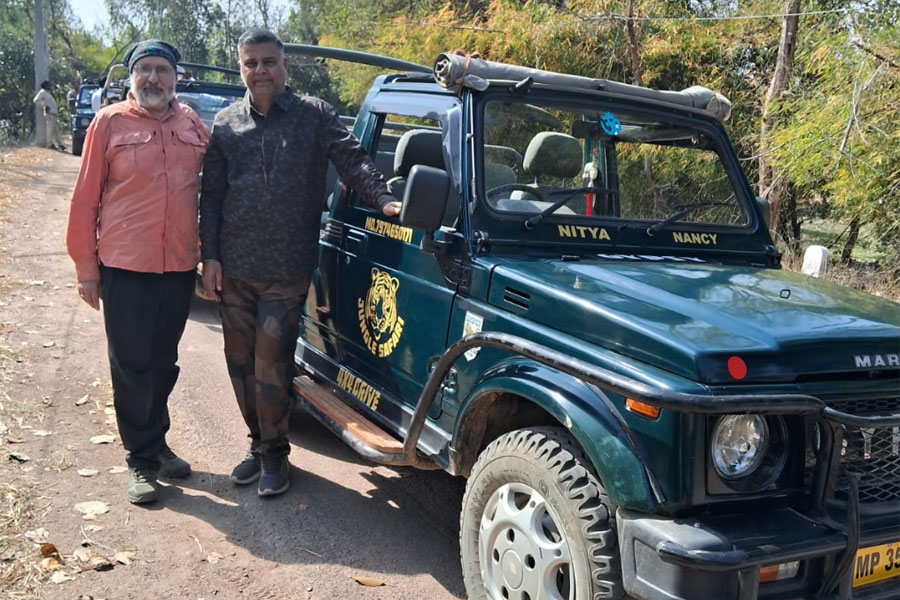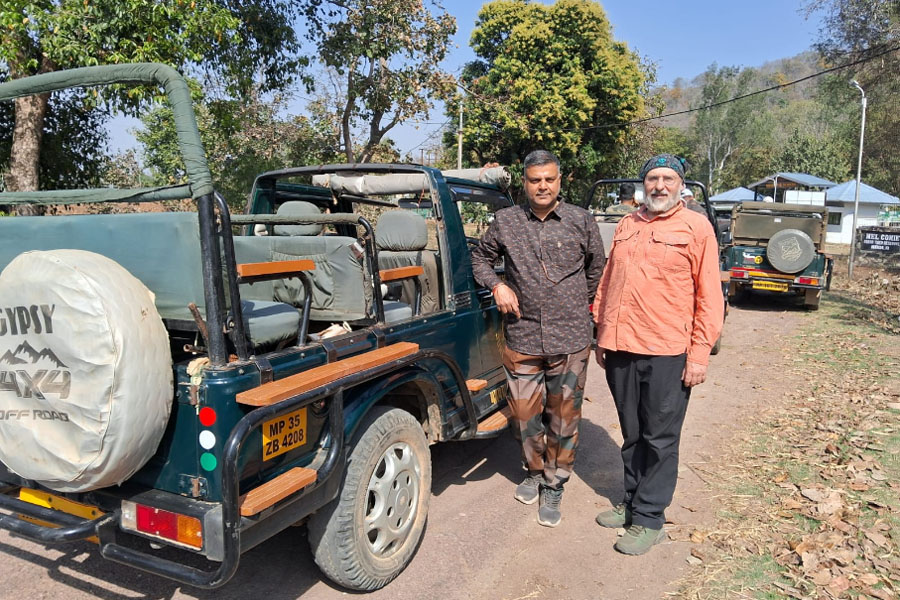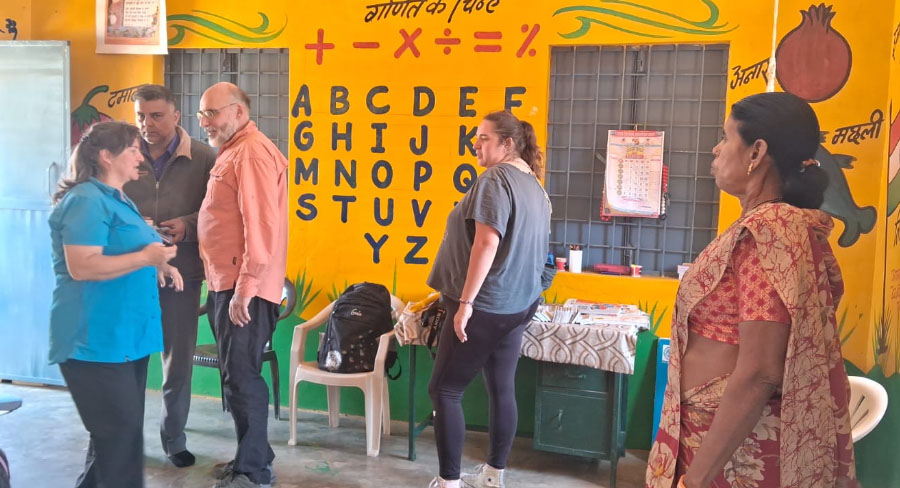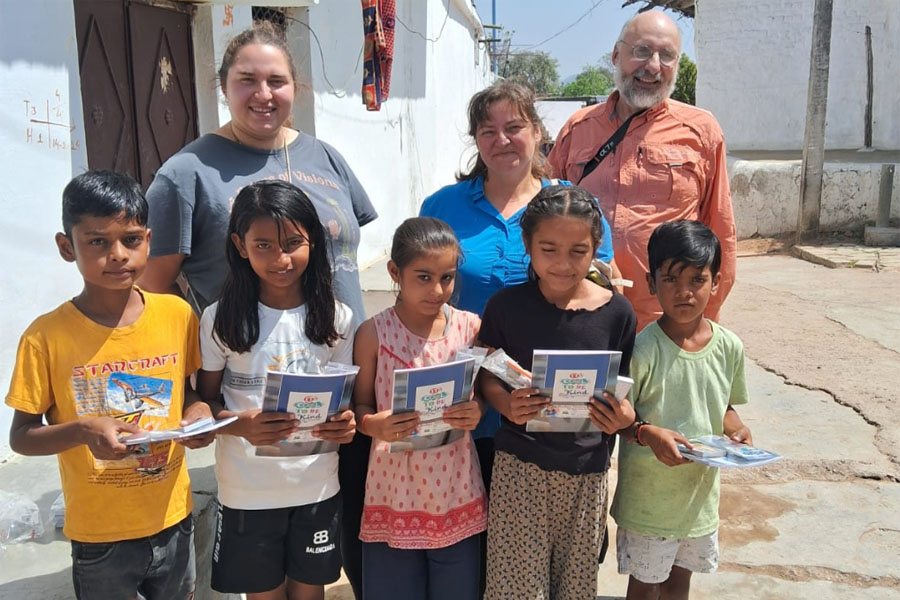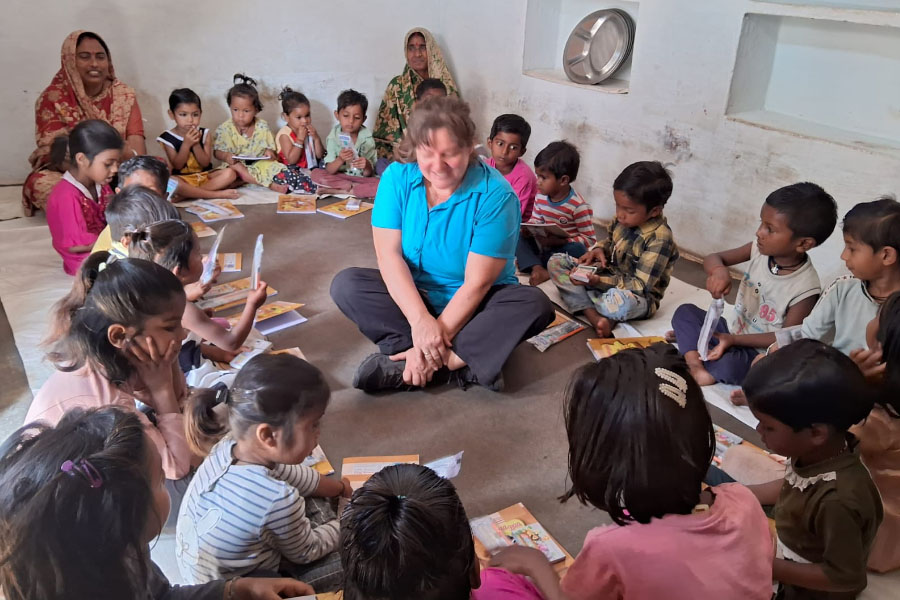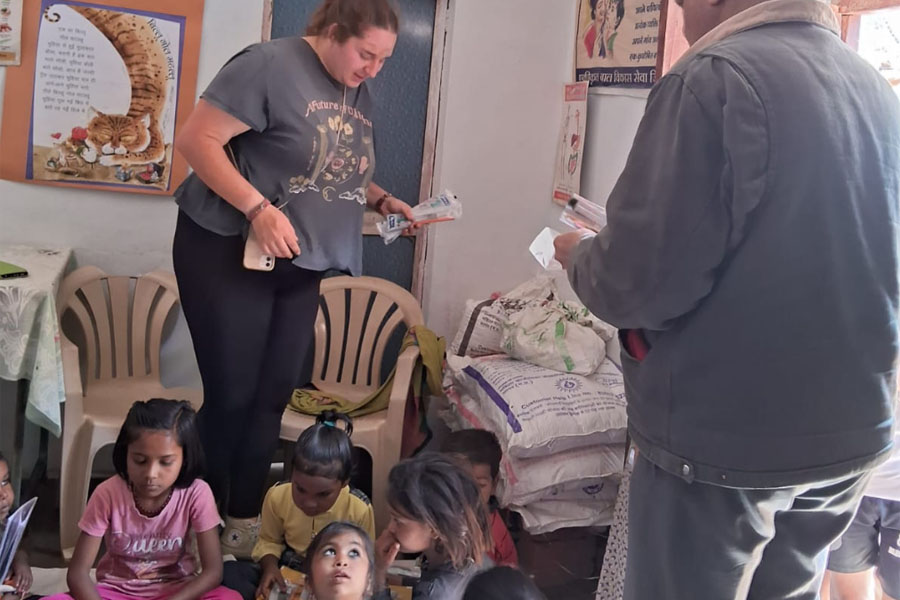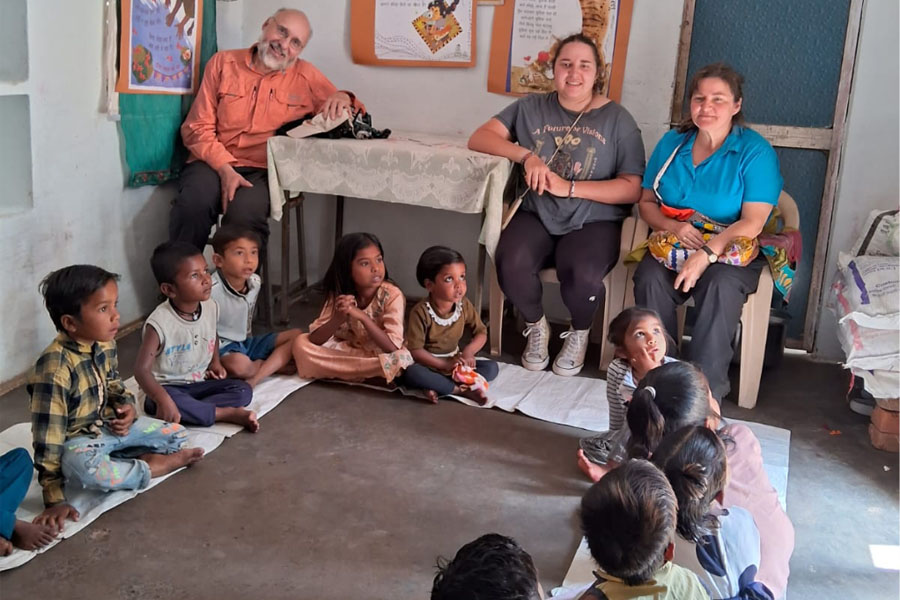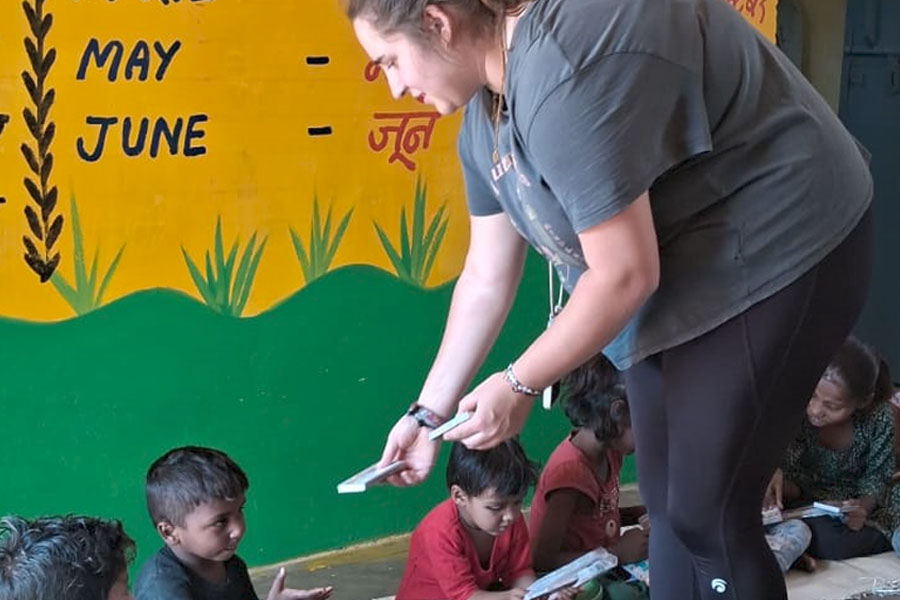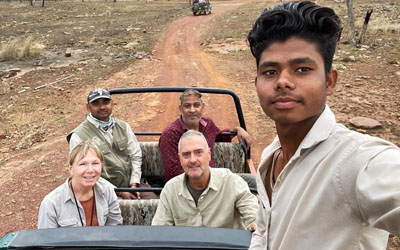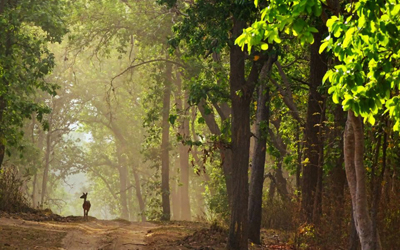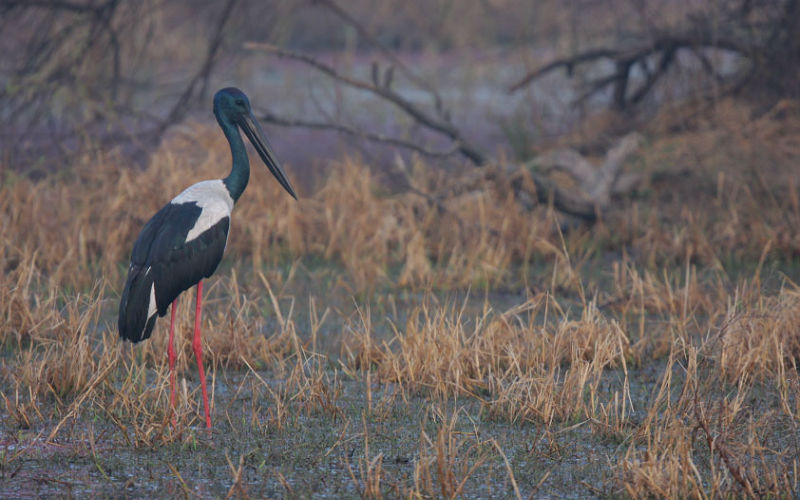Mr. Manish Sharma shared the story of Dr. Volker and their family’s trip to India Wildlife from March 15-22, 2024. He recounted their experiences and where they were able to spot tigers and other wild animals during their adventure.
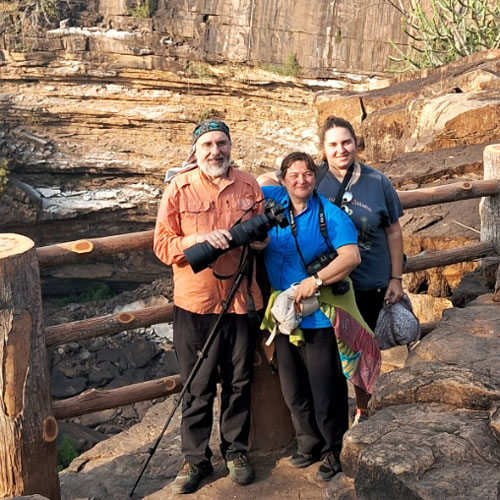
Dr. Volker Sandig
Chief Scientific Officer
Summary.
Total Tiger sightings: 10
Total Different Tigers: 10.
Total Leopards: 04 (03 in day & 01-night safari)
Total Sloth Bear: 02 (01 in day & 01-night safari)
Tour Guide: Manish sharma.
Panna Guide: Pahad Singh.
Pench Guide: Ramprasad.
Umred Guide: Prashant.
Mumbai Guide: Noshir.
On January 21, Dr. Volker Sandig sent us an email about their trip to India on March 24. As usual, he also asked about the Ranthambhore safari and we found out that all jeeps were sold out due to a faulty booking system at Ranthambhore. The department used to open advance bookings 365 days prior to the visit date but starting from May 24, they realized their mistake and changed it to only allow bookings up to 90 days in advance. Unfortunately, this decision has ruined two years’ worth of seasons for good tourists as even on December 24th, all good zones are already sold out.
Mr. Volker, Grit (his wife), and Carolene (his daughter) are all good photographers. So, selecting a good park for them was a bit challenging. For us, this is still not a big issue as we receive updates of sightings from various parks from our field guides on a daily basis.
We shared all sighting updates with Mr. Volker, and finally we decided to visit Panna National Park, Pench National Park, and Umred Karhandla Wildlife Sanctuary.
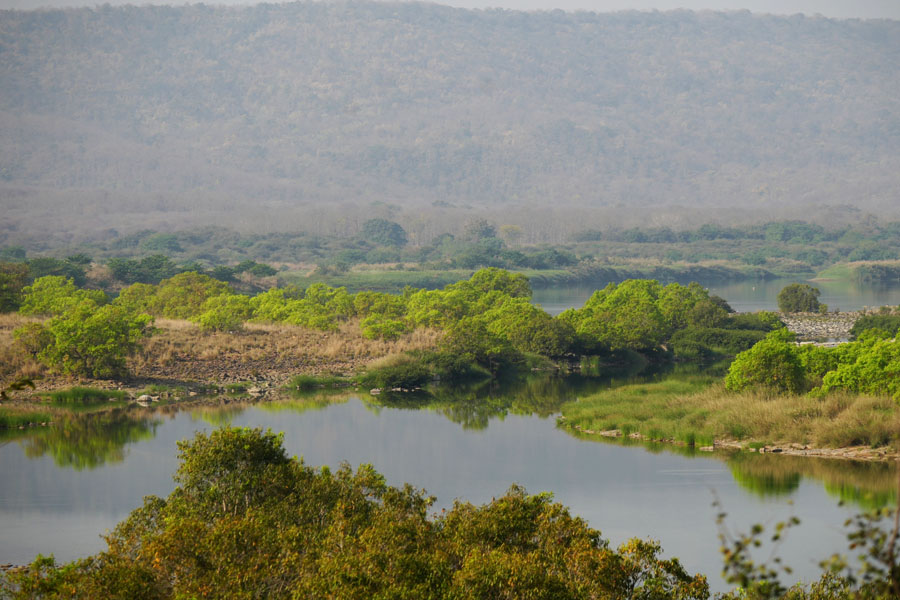
Our wildlife adventure on the trip began in Agra on March 14th. We took the Gatiman Express from Agra at 10:00 am and arrived in Jhansi at 12:35 pm. Dr. Volker, who had been to India many years ago, decided to spend a few hours exploring the Khajuraho temples, which are a UNESCO World Heritage site. In the evening, we reached Panna Resort.
On March 15th, 2024: During the morning safari, we saw two cubs with a beautiful river bed in the background.
Panna National Park in India is a popular destination for tourists due to its welcoming atmosphere and friendly staff. The park has learned from past mistakes, as it faced the loss of all but one tiger about 15 years ago. However, through efforts such as bringing in tigers from neighboring parks like Bandhavgarh, Sanjay Dubhri, and Kanha National Park, Panna now boasts impressive sightings comparable to other well-known destinations like Ranthambore, Kanha, and Bandhavgarh.
We started quite early from our hotel. Zone Madla is a very famous zone in Panna. This is the main zone where two tigresses, T151 and her four cubs, and T141 and her two cubs roam freely. Both tigresses are bold enough to try leaving their cubs in tourists’ vehicles.
After driving for 30 minutes, we spotted two cubs of T151 in the river area. They were nearby and we were able to take some good pictures of them. Our guide Pahad Singh is one of the finest naturalists/guides in Panna. He knows how to track tigers and provide the best angles for photographers.
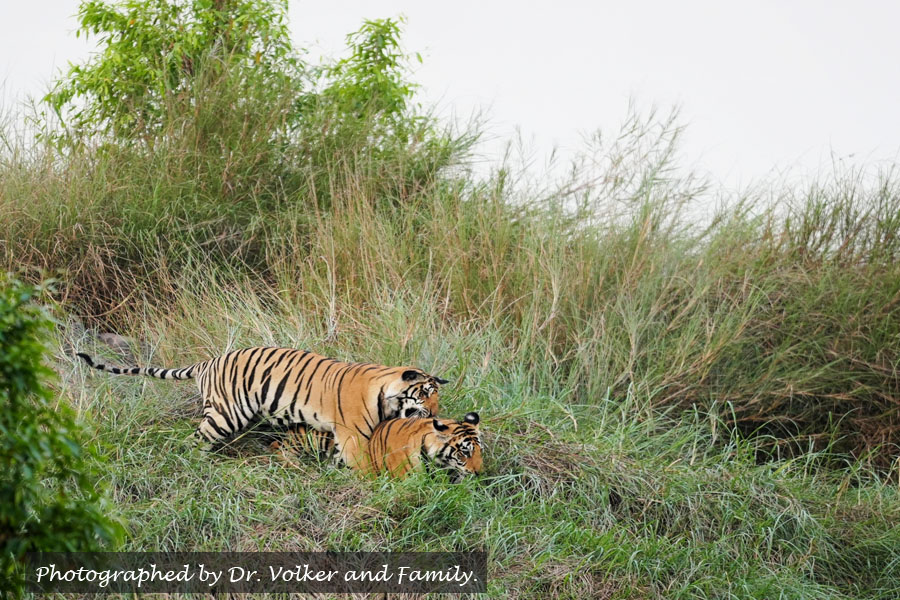
On March 15th, 2024: During the afternoon safari, we saw vultures and two cubs of P151
in good light.
This afternoon, we entered the park and tried to locate T141 but were not successful. In the winter, she was seen mating two or three times with a huge male. Her last cubs left her and carved out their own territory; they are now around two years old. So, we went up to Pipertola area’s grassland to trek her but found no signs of warning calls or pug marks. Our guide Pahad Singh decided to go up to Vulture Point.
While driving up to Vulture’s Point, we saw a huge male tiger named P653. However, it was far away and only Grit Mam was able to photograph it. This is a nice place on the highest tier of Panna where one can find many vultures in nests and open areas. If you are going to Panna, then Vulture’s Point is a must-visit spot. It is close to the Hinouta area.
We took some photographs of vultures and while we were returning, we saw the same tigers from earlier in the morning. So, our first day was very successful from a photography point of view.
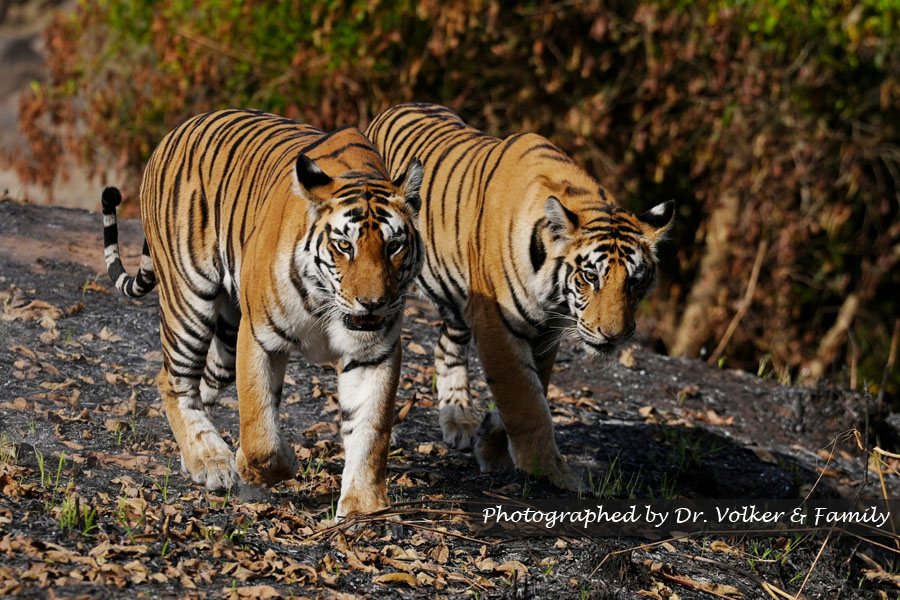
On the evening of 15 March 24, a sloth bear & leopard was spotted in the Night Safari at Jinna Buffer Zone.
If someone is looking to experience a night safari, there’s nothing like Panna’s Jinna buffer zone. There are night safari options in every national park in Madhya Pradesh (central India). Based on sighting records in Panna, one can see Civet cats, Sloth bears, and leopards.
We were lucky to see a sloth bear on this night safari. We always offer the option of a night safari to our clients in Panna if time permits us.
On the morning of March 16th, 2024: There were two different cubs spotted: T151 and a sloth bear.
We started with prayers to see the whole family of T151. After trekking for one and a half hours, we suddenly heard the call of a Sambhar deer. We stopped for a while and slowly two cubs came out of the bushes and sat near our Jeep. These cubs were different from the ones we saw yesterday. Later, we went to have breakfast at a scenic spot. On the way, we also spotted a huge sloth bear which was an unexpected addition to our Big Five list on this photo trip.
I thanked God for showing four of five family members. Now, only my mother was left to complete the family.
Afternoon of March 16th, 2024: Two cubs of T151 & birding.
Our expectations became too high after seeing four cubs, so we were focused on finding the mother.
We checked all possible areas for the mother, but were not successful. Actually, T151 is training them to become independent killers. So, she often leaves them alone and spends time in remote areas. For her, it is very tough to manage food for all four cubs. These cubs are also learning how to kill and make small deer kills frequently.
On March 17th, 2024 in the morning, T151 was seen with all four cubs together.
Today was our last day in Panna and the second-to-last safari. We started as usual at 05:30 am. Nature always has the best for us if we go with full belief. The action started late around 09:30 am on this day. Our guide heard the growling of T151 and decided to wait at the river bank. Calls from monkeys and Sambhar deers confirmed the presence of a Big Cat.
After waiting for 45 minutes, T151 and her cubs started walking on the bank around 10:28 am. The whole episode lasted for another 45 minutes. The lighting was good and this time all four were captured in one frame. It was difficult to get all five of them together while they were walking. In the video, all five appeared in one frame.
Capturing the maximum number of tigers in one frame is any photographer’s dream, and we were lucky enough to achieve it.
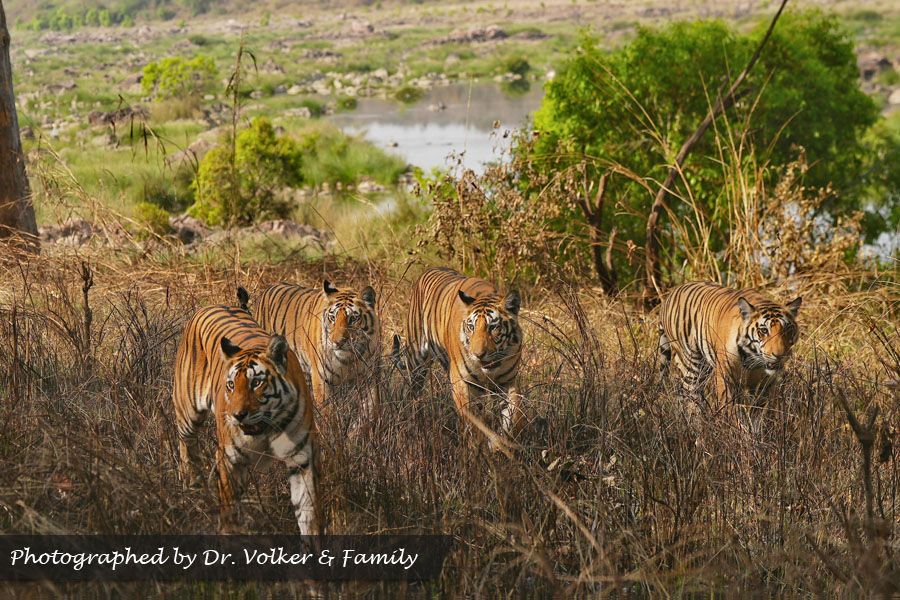
March 17, 2024 Afternoon: No sightings, but we explored the Hinouta and Madla zones.
This was our last safari in Panna. After enjoying a family together in T151 during the morning shift, we reached the same place where they were sighted earlier. However, they had already left and most likely crossed the river. So, we went to the T141 area but she was not seen.
We needed to catch the train at 00:15 from Jhansi station to Nagpur. So, after our morning safari, we checked into the hotel and left our baggage at reception. After the safari, we took a short break to use the washroom and have some tea before starting our drive to Jhansi. We arrived in Jhansi around 10:30 pm where we had dinner before heading to the railway station to board our train. We chose Rajdhani (a premium train) for an overnight journey which was comfortable and arrived at Nagpur station around 09:30 am.
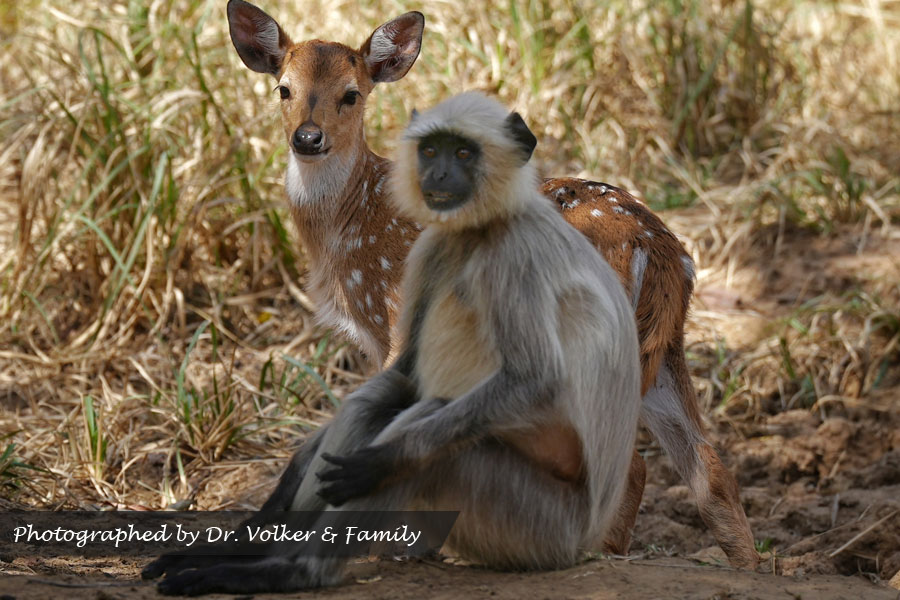
March 17, 2024 Afternoon: No sightings, but we explored the Hinouta and Madla zones.
This was our last safari in Panna. After enjoying a family together in T151 during the morning shift, we reached the same place where they were sighted earlier. However, they had already left and most likely crossed the river. So, we went to the T141 area but she was not seen.
We needed to catch the train at 00:15 from Jhansi station to Nagpur. So, after our morning safari, we checked into the hotel and left our baggage at reception. After the safari, we took a short break to use the washroom and have some tea before starting our drive to Jhansi. We arrived in Jhansi around 10:30 pm where we had dinner before heading to the railway station to board our train. We chose Rajdhani (a premium train) for an overnight journey which was comfortable and arrived at Nagpur station around 09:30 am.
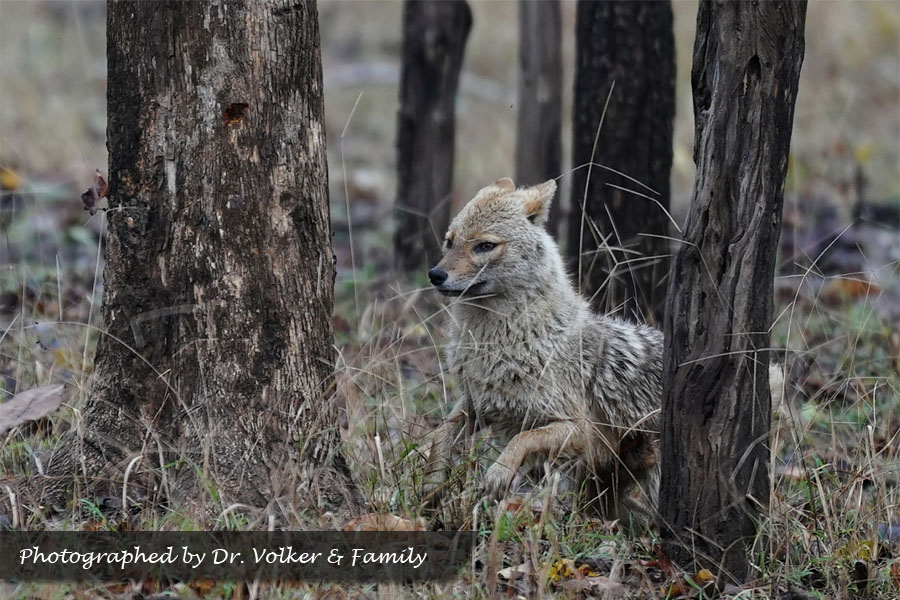
March 18, 2024 Afternoon: Khusapar Zone and Tigress Bindu.
It takes 01:30 hours to drive from Nagpur to Pench. We checked into the hotel and got ready for our first safari in the Khursapar zone. Our guide, Ramprasad Inwate, has over 15 years’ experience and is very knowledgeable. Khursapar is considered one of the best zones in Pench (Maharashtra part) due to its thin vegetation which makes it easier to spot tigers and tigresses who are known for their boldness. The weather suddenly changed with a thunderstorm and rain on this day but our guide didn’t give up. Despite the bad weather, we were lucky enough to see the Bindu tigress thanks to our determined guide.
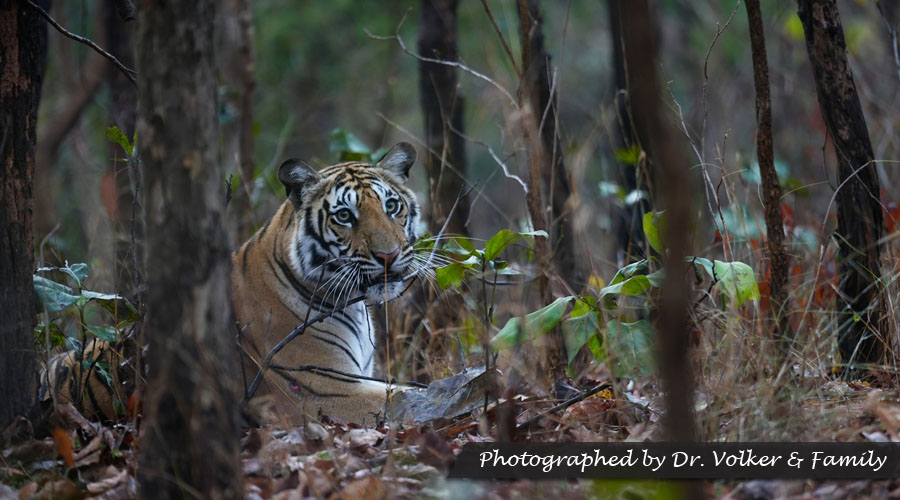
On the morning of March 19th, 2024 I saw a leopard from a distance in the Turia zone.
Pench National Park is located on the border of Madhya Pradesh and Maharashtra states. The Touriya zone falls within Madhya Pradesh, while only the core area of Pench is in Madhya Pradesh. However, there are several core zones in the Maharashtra part with some distance between them. At least Khursapar and Touriya are must-visits to fully experience Pench.
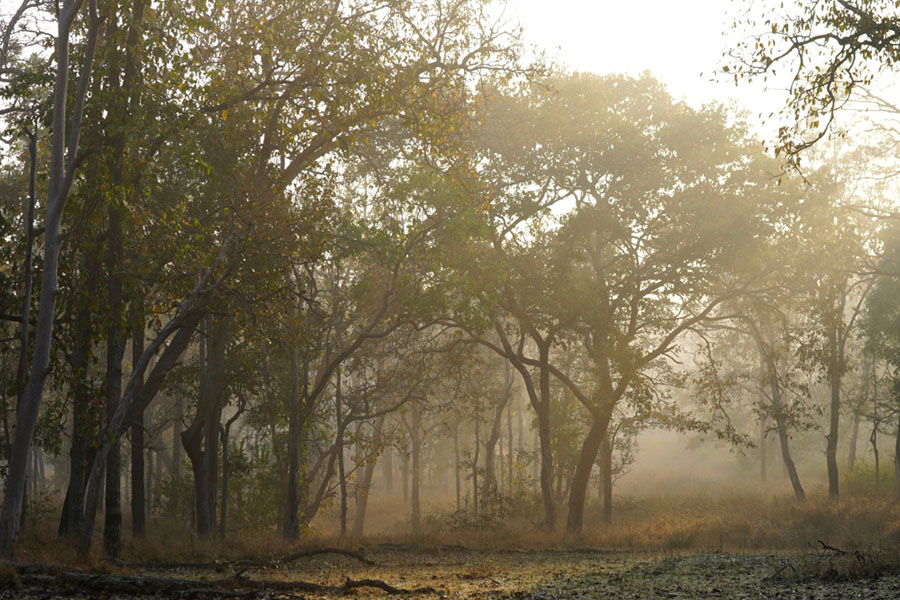
The rain on March 18th weakened the chances of spotting a tiger, but we were able to see a leopard from a distance.
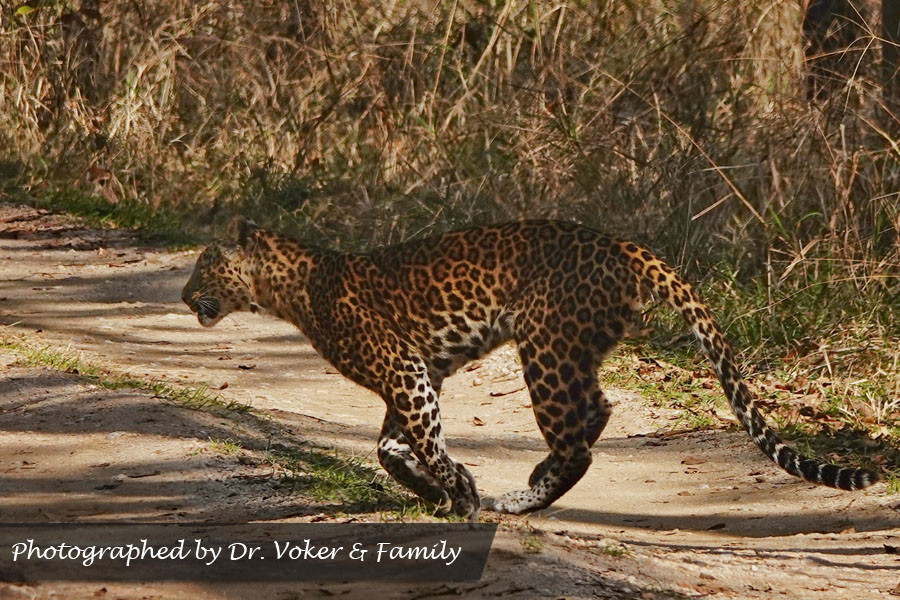
On March 19, 2024 in the afternoon, there was an incident in Sillari zone where a leopard tried to kill a mongoose and a viper snake.
The Sillari zone is another highly demanded area after the above two zones in Pench. The terrain is hilly, which provides a good habitat for leopards to thrive. Additionally, there are grasslands for tigers to roam on. This afternoon, due to rain impacts, we were unable to spot any tigers but we did see a leopard attempting to kill a mongoose. Although we couldn’t capture it on camera, it will be etched in our minds forever. As we were about to leave the park and head towards the main road, we spotted a huge viper snake.
On the morning of March 20, 2024 in the Touria zone, there was a good sighting of a leopard for photography.
During the morning safari, the weather was still cloudy but I thanked God that it did not rain the previous night. We started from our hotel at 5:30 am and ventured through the whole zone. Later on, we were able to capture a leopard with our camera. Whenever it rains in Central Indian parks, tigers’ movements become sluggish and there are more chances of seeing leopards.
On March 20th,2024 in the afternoon, at Khursapar zone, two young tigresses B2 & P were spotted.
This was our last safari in Pench’s Khursapar zone. We tried to balance the selection of zones based on input from our field guides. The weather was improving, so everyone remained positive about seeing at least one tiger and increasing the tally numbers.
After entering the park, Ramprasad did not speak much to us. He was checking every possible point for tiger movements. After a lot of concentration and hard tries, we were lucky to see B2 (daughter of Baras Tigress) and P Mark (daughter of Bindu Tigress).
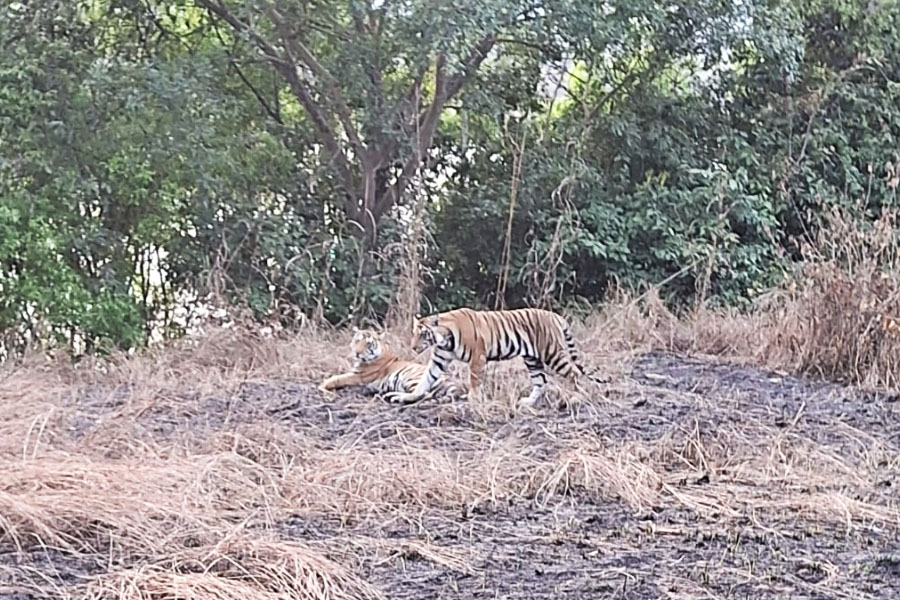
So, the last safari in Pench made up for the lack of sightings in the Touria zone.
After the safari, we drove directly to Umred Karhandala Wildlife Sanctuary which is a 01:15 minute drive from Pench.
On March 21st, 2024 Morning: There were no sightings in the Gothagaon zone.
Umred Karhandala is a beautiful small park near Nagpur. If you want to go on a safari and can’t find any in the bigger, more well-known parks, then this place will not disappoint you. Additionally, there are wild dogs in the park. This sanctuary was chosen by Sudhir with hopes of seeing a tigress with her small cubs out of all three parks: Panna, Pench and Umred. Our guide Prashant was full of confidence during our visit.
The cubs of F2, a female, were the youngest in all the parks. This day was going to be very challenging from a sighting point of view; no one could have imagined it. But nature always has something to teach us. Sights are not under our control.
The morning safari was disappointing, but we were positive about the afternoon safari.
21 March, 2024 Afternoon: There are no sightings in the Gothagaon zone.
Karhandala and Gothangaon are adjacent zones, but their gates are 20km apart.
We were all gearing up to locate the F2 female, but unfortunately we were not successful. While at a common water hole between two zones, there were alarming calls of Sambhar and spotted deer. This gave us hope that we would see our first tiger in Umred Karhandla as we assumed the tigress would come to our zone. However, it did not happen. Sometimes in each park, there are safaris with no sightings and one should be mentally prepared for this possibility.
On March 22, 2024 in the morning, a tigress was spotted with an X mark in the Karhandala zone.
Our photo trip was without any tiger sightings, which put everyone under pressure. In such conditions, we started praying to Goddess Durga, whose vehicle is the tiger itself. We prayed the previous night until we went to sleep.
We started our safari in Karhandala early in the morning. As soon as we entered the park, the first animal we saw was a pregnant tigress who had just arrived from the high grass beside the road. Everyone was stunned and at that moment, only our Jeep was there to witness this amazing sight. It felt like a blessing from Goddess Durga herself. This exclusive sighting will always be remembered as one of the highlights of our trip by Dr Volker.
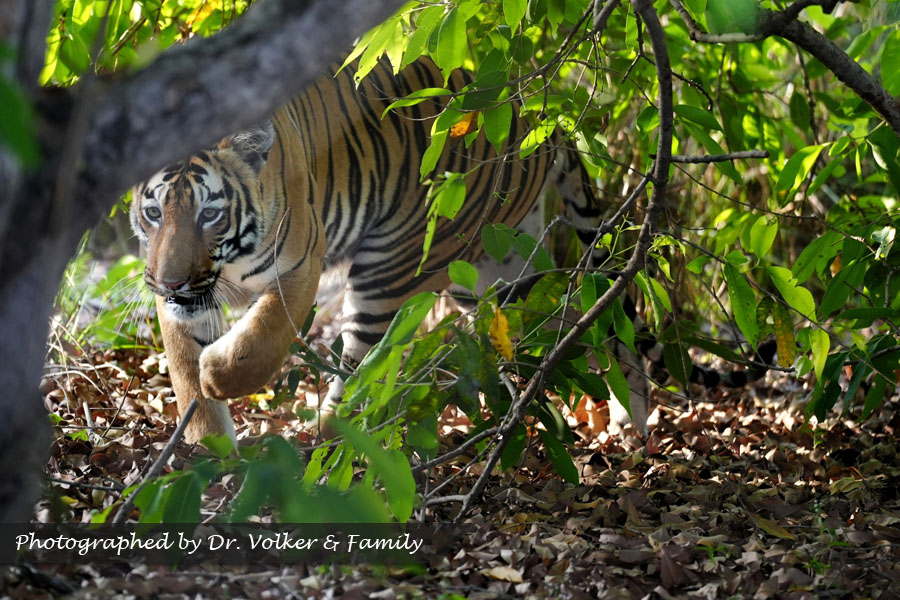
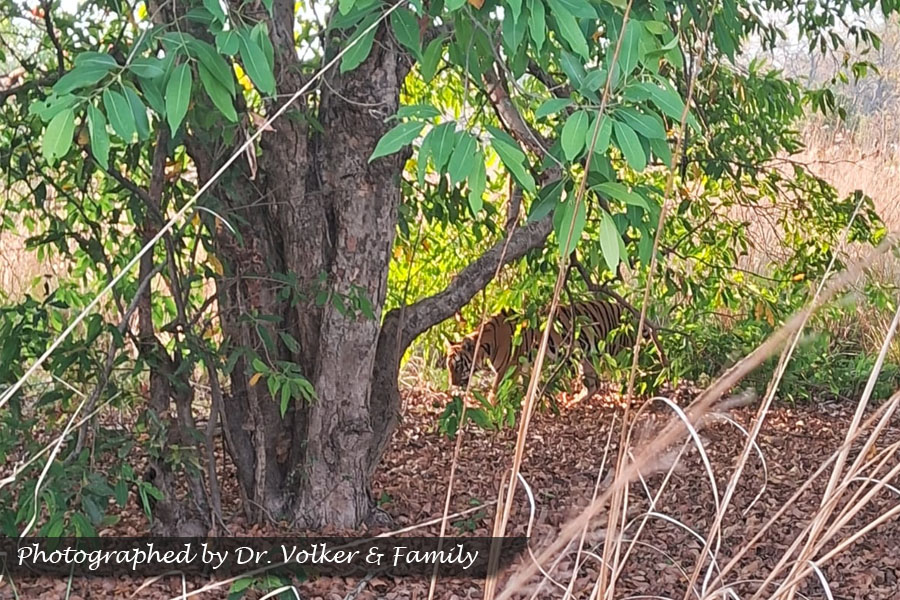
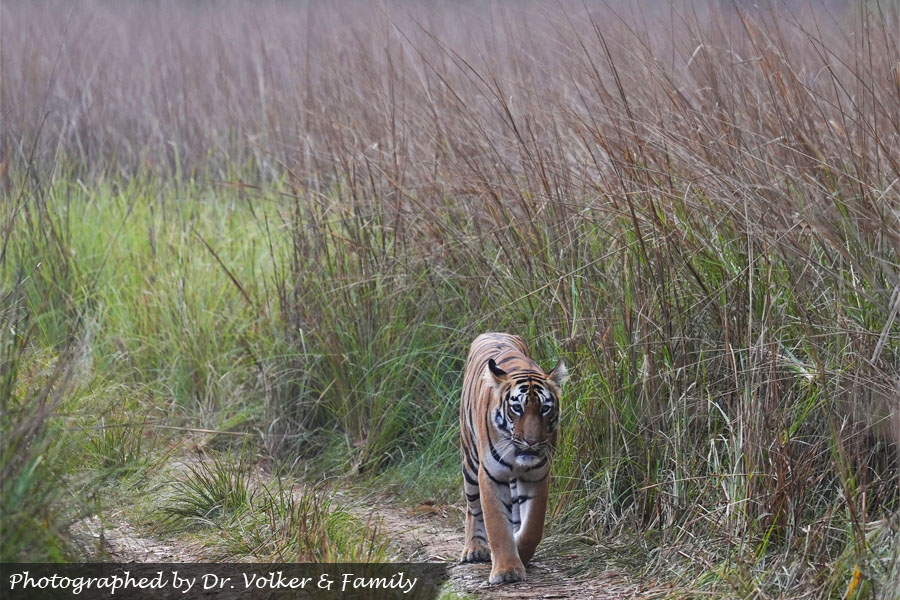
After our last exclusive tiger sighting, we left the park as Dr. Volker and his family had to catch a flight for Karnataka while Gao went to Nagpur airport.
Dr. Volker Review and Safari Videos
Social Responsibility
Travelling is often defined as connecting to the local community.
If you are not connecting with local people or children, then something might be missing.
During our multi-day trips, we try to organize this.
The best way to connect with the local community is by visiting schools.
So we set aside some time during the trip for a school visit. During this, we spent a portion of the tour providing study materials such as notebooks, pencils, and drawing sheets.
This, in turn, helps kids understand the value of tigers and hopefully turns them into good conservationists in the future. In addition to this, some part of the tour is spent helping very poor individuals with medical needs.
Many NGOs like Ketto, Give Hope, Health Impact run crowd funding for needy persons & we happily contribute or share with them.
